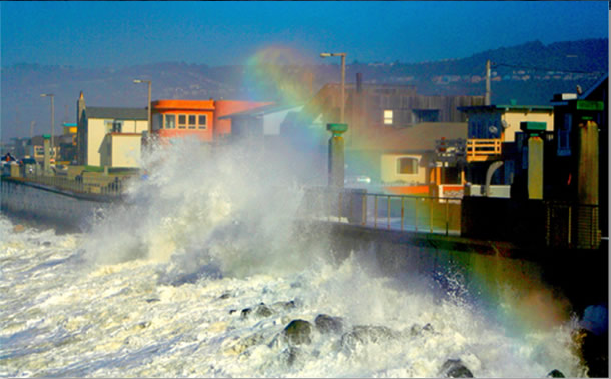Sea Spray Bows
Sea Spray Bows: A Spectacular Phenomenon Unveiled
Have you ever witnessed a captivating display of nature's artistry known as sea spray bows? These ethereal phenomena, often found along coastal regions, offer a mesmerizing spectacle that is slightly different from the familiar rainbows we encounter. In this article, we will delve into the fascinating world of sea spray bows, exploring their characteristics, formation, and the unique factors that set them apart from their rainwater counterparts.
Sea spray bows, like rainbows, are optical phenomena that occur when sunlight interacts with water droplets suspended in the atmosphere. However, there are some key distinctions that make sea spray bows a remarkable sight to behold. One of the primary factors influencing their appearance is the refractive properties of saltwater. Saltwater has a higher refractive index compared to freshwater, causing light to bend more significantly as it passes through sea spray droplets.
The difference in refractive properties between saltwater and freshwater results in sea spray bows being slightly smaller in size compared to rainbows formed from rainwater. This disparity becomes particularly noticeable when sea spray bows and regular rainbows manifest side by side. The contrasting radii and dimensions create a striking visual juxtaposition, further enhancing the allure of these coastal wonders.
To gain a deeper understanding of sea spray bows, let us explore their formation process. When waves crash against the shoreline or rocks, they create a fine mist of water droplets that become suspended in the air. These droplets act as tiny prisms, refracting and dispersing sunlight into its constituent colors. As a result, an arc of vivid hues emerges, resembling a semi-circular band of vibrant colors gracefully suspended above the sea.
The unique conditions required for the formation of sea spray bows contribute to their relative rarity compared to rainbows. While rainbows can be observed under various weather conditions, sea spray bows typically require specific circumstances to occur. Strong ocean waves, combined with favorable wind patterns and ample sunlight, create the ideal environment for the formation of sea spray bows. Consequently, these phenomena are more commonly observed in coastal regions characterized by tumultuous seas and frequent wave action.
In addition to their distinct formation process, sea spray bows also exhibit subtle variations in color intensity and saturation compared to rainbows. The presence of salt particles in the sea spray droplets contributes to the scattering of light, resulting in a more pronounced bluish tinge in the bow's inner edge. This unique characteristic adds a touch of mystique to sea spray bows, setting them apart from their rainwater counterparts.
Captivated by the allure of sea spray bows, photographers and nature enthusiasts alike have sought to capture their beauty. Mila Zinkova, a talented photographer, has been fortunate enough to witness and document these mesmerizing phenomena along the California coast. Through her lens, she has immortalized the delicate dance of light and water, showcasing the breathtaking splendor of sea spray bows for all to admire.
In conclusion, sea spray bows offer a captivating display of nature's brilliance, distinct from traditional rainbows. Their smaller size, caused by the stronger refraction of light in saltwater, sets them apart from rainwater rainbows. The formation of sea spray bows relies on specific conditions, including powerful ocean waves, suitable wind patterns, and ample sunlight. These factors contribute to their relative rarity compared to rainbows. With their unique color variations and enchanting presence, sea spray bows serve as a testament to the mesmerizing beauty that can be found along our coastal regions.


Sea spray bows.
Mila Zinkova (site) saw these on the California coast.
Sea spray bows are slightly smaller than ones from rain water because salt water refracts light more strongly. The difference in radius is noticeable when sea-spray and ordinary rainbows occur next to each other.
Images ©Mila Zinkova, shown with permission.
Note: this article has been automatically converted from the old site and may not appear as intended. You can find the original article here.
Reference Atmospheric Optics
If you use any of the definitions, information, or data presented on Atmospheric Optics, please copy the link or reference below to properly credit us as the reference source. Thank you!
-
<a href="https://atoptics.co.uk/blog/sea-spray-bows/">Sea Spray Bows</a>
-
"Sea Spray Bows". Atmospheric Optics. Accessed on April 18, 2024. https://atoptics.co.uk/blog/sea-spray-bows/.
-
"Sea Spray Bows". Atmospheric Optics, https://atoptics.co.uk/blog/sea-spray-bows/. Accessed 18 April, 2024
-
Sea Spray Bows. Atmospheric Optics. Retrieved from https://atoptics.co.uk/blog/sea-spray-bows/.